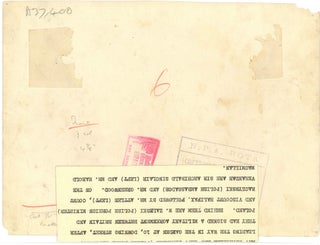An original wartime press photograph of Prime Minister Winston S. Churchill and Polish General W adys aw Sikorski, accompanied by a number of high level British and Polish officials, in the garden of 10 Downing Street following the signing of the Anglo-Polish Agreement of 5 August 1940
London: Copyright N.P.A. Rota, published by The Daily Telegraph, 5 August 1940. Photograph. This original press photograph captures Prime Minister Winston S. Churchill and Polish General W adys aw Sikorski, accompanied by a number of high level British and Polish officials, in the garden of 10 Downing Street following the signing of the Anglo-Polish Agreement of 5 August 1940. The gelatin silver print on matte photo paper measures 7.5 x 10 inches (19 x 25.4 cm). Condition is good plus. The paper is crisp, clean, and free of scratches with some wear to the edges, largely confined to the margins, loss to the upper left and lower right corners, creasing to the lower left corner, and a pin hole to the upper right corner.
This press photo was once a part of the working archives of The Daily Telegraph and features their Art Department's original, hand-applied retouching to the figures’ clothing and faces, including that of Churchill. The verso bears the copyright stamp of “N.P.A. Rota”, a published stamp of The Daily Telegraph dated “6 AUG 1940”, and a typed caption reading, “MR. CHURCHILL AND GEN. SIKORSKI (POLISH PRIME MINISTER) LEADING THE WAY IN THE GARDEN AT 10, DOWNING STREET, AFTER THEY HAD SIGNED A MILITARY AGREEMENT BETWEEN BRITAIN AND POLAND. BEHIND THEM ARE M. ZALESKI (POLISH FOREIGN MINISTER) AND VISCOUNT HALIFAX, FOLLOWED BY MR. ATTLEE (LEFT), COUNT RACZYNSKI (POLISH AMBASSADOR) AND MR. GREENWOOD. ON THE VERANDAH ARE SIR ARCHIBALD SINCLAIR (LEFT) AND MR. HAROLD MACMILLAN.”
General Sikorski (1881-1943) led Poland's government in exile. On 1 September the German army invaded Poland, prompting Britain and France to enter the war in accordance with preceding security accords. On 5 August 1940 a further agreement was signed, documenting that the Polish Armed Forces were a sovereign military under the constitutional control of the Polish Government in exile. Sikorski’s British liaison officer, Victor Cazalet, recorded the day and the unexpected move to bring in photographers in his diary, “Polish Agreement signed 10 Downing Street, inside Cabinet Room, Winston at last minute insisted on photographer coming into the Cabinet Room. We had all been told that was the one thing that was not to be done. He was very distracted while we were in the garden and could not be got to do anything but smile. We all drank champagne and all the Polish officers, etc., whom I brought in, were very pleased as the whole Cabinet came down and made themselves pleasant.” (Gilbert, Documents XV, 616)
Churchill's relationship with Poland would have controversies. On 5 July, 1943, the Liberator bomber carrying General Sikorski crashed immediately after taking off from Gibraltar. Sikorski's death fueled conspiracy theories, as the cause of Polish sovereignty was a thorn in the side of relations between the American, British, and Soviet Allies. Certainly, Sikorski’s death proved a blow to Polish independence; Poland was effectively ceded to the Soviet sphere of influence for the long Cold War that followed the Second World War. Despite the inconvenience of the Polish cause to Allied relations, Churchill was publicly supportive of Sikorski and Poland. Churchill is reported to have wept upon receiving the news of Sikorski's death (Gilbert, Vol. VII, p.426). On 6 July, 1943, Churchill gave a tribute to Sikorski in the House of Commons.
During the first half of the twentieth century, photojournalism fundamentally changed the way the public interacted with current events. Newspapers assembled expansive archives, including physical copies of all photographs published or deemed useful for potential future use, their versos typically marked with ink stamps and notes providing provenance and captions. Photo departments would often take brush, paint, pencil, and marker to the surface of photographs themselves to edit them before publication. Today these photographs exist as repositories of historical memory, technological artifacts, and often striking pieces of vernacular art. Item #005026
Price: $300.00


